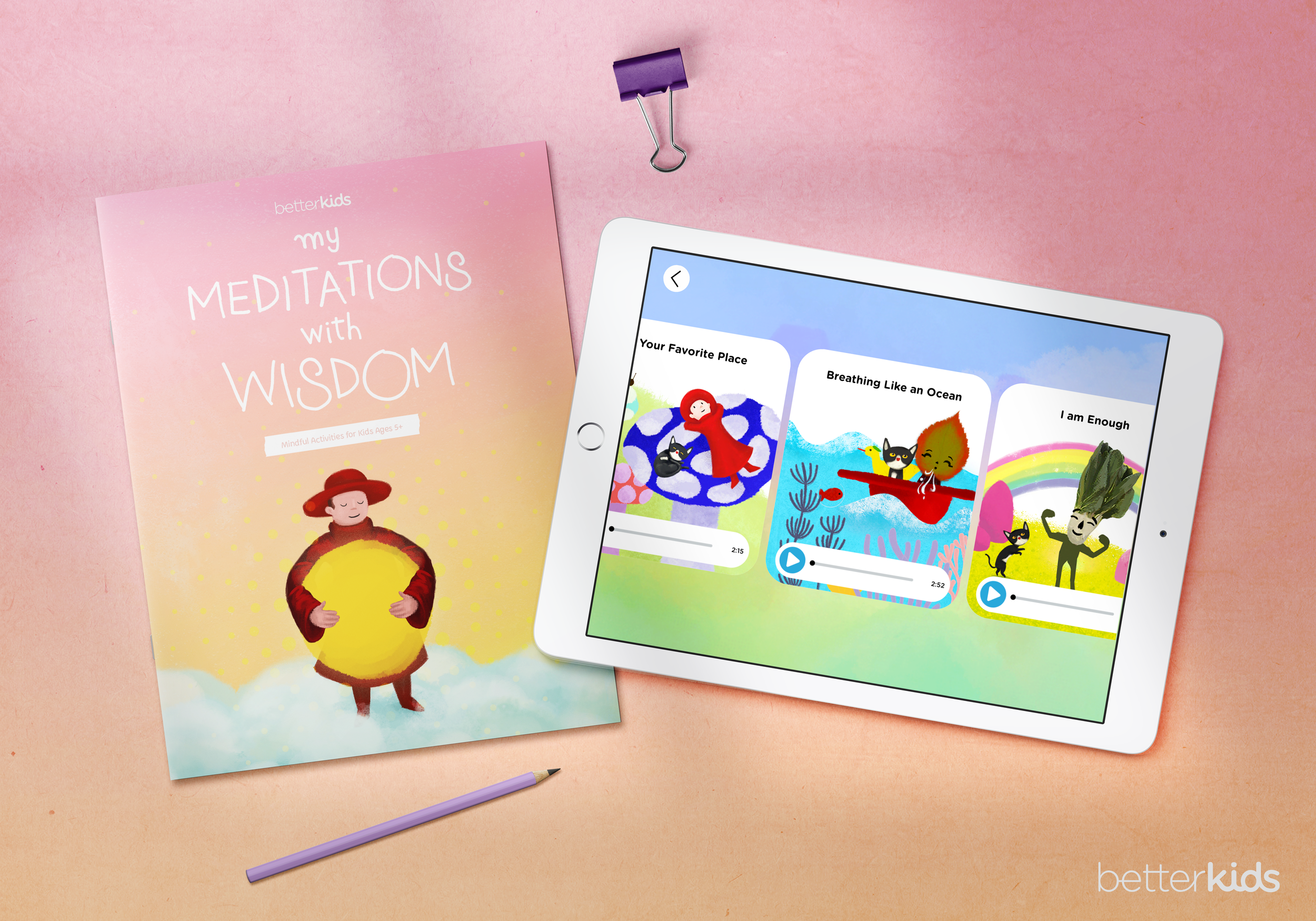A few months ago, I played a guided meditation for my students for the first time. My fidgety, mix of 3 to 5 year olds who were still waking up from nap time and hungry for afternoon snacks sat still for a few moments as they listened to Wisdom’s voice. When they heard Wisdom ask them to close their eyes, I noticed one of my students who sat next to me frequently look over at me to see if my eyes were closed. As I modeled for them the sitting, breathing, and listening, I realized it was exactly what we needed in that moment. After a rollercoaster of a day of emotions and still an afternoon left to socialize and learn, we all needed a moment to sit, and breathe. During Mental Health Awareness Month especially, we want to teach our children that establishing healthy habits for our minds, and taking care of our emotions is as important as establishing healthy habits for our bodies.
Benefits of Meditations
After listening to a guided meditation called You are the Sun (featured in Wisdom: The World of Emotions (iOS, Android)), one of my students came up to me with a big smile on his face and said “I feel happy”. Given the many challenges he is facing both at home and at school, it struck me how this practice can be beneficial for all children.
Just like adults, when children feel stressed or worried, their body enters fight-or-flight mode and cortisol levels increase which can cause mood swings and high blood pressure. When children practice focusing their mind on their breathing or thoughts for a short period of time, not only does it activate their parasympathetic nervous system and increase serotonin levels (making them feel happier and more positive), it also decreases the activity in their sympathetic nervous system. As a result, meditations help children and adults ease stress, reduce depression symptoms, and self-regulate effectively.
Mindworks shares that there are additional benefits to meditations, such as:
Enhanced focus: Meditations will help children, and adults, focus on one thing at a time without distractions such as technology.
Foster compassion and self-esteem: Children can be harsh critics towards themselves when faced with new challenges or setbacks. Meditations such as I am Enough (featured in Wisdom: The World of Emotions (iOS, Android)) help children reflect on their inner selves and affirm that they are unique, capable individuals. The book My Meditations with Wisdom includes affirmation cards for kids to create and have as reminders that will build their self-esteem.
Boosting confidence: The confidence children will build by meditating and other mindful activities will help them to better recognize and manage their emotions. When faced with something new, something difficult or unpleasant, instead of being overwhelmed with anxiety, the positive train of thought nurtured by meditations will help them stay grounded and confident.
Build empathy and happiness: Meditations such as those found in Wisdom: The World of Emotions, will remind children to consider the perspective of others, reflect on their support systems, and feel gratitude for the people, places, and things that make them happy.
Children who have ADHD or are hyperactive may also be able to better manage their challenges with the help of mindful activities such as meditations. Additionally, if children practice meditations and mindfulness consistently they will have improved sleep, self-regulation, better creativity and retention of information, and an improvement of their overall well-being.
How to Use Meditations: Get started with these 3 simple steps
Step 1: Introduce Meditation
First, you may need to explain to your child or student about what meditation is and why we meditate. Some example explanations include:
A meditation is a short story to help us think about our day or our feelings
A meditation is an encouragement and positive reminder for our day
A meditation is a listening activity
A meditation is an exercise to help our brain create helpful thoughts and grow
A meditation is a practice to de-clutter our mind and help us feel happier and less worried
A meditation is a way to feel calmer and to help us become ready to problem-solve
It is important to remember that children might not be receptive to meditating if they feel as if it is a chore. Try encouragements such as “I’m going to sit and listen to this meditation for a few minutes, would you like to join me?” or “After we read a story before bedtime, I have a meditation we can listen to, would you like to hear it?” Children’s meditations should be shorter in duration when first starting as to gradually help them increase their ability to focus.
Step 2: Be creative
While it’s never too early to introduce meditations, parents and educators can choose how to do so based on the child’s interests.
Audio meditations
You can start by playing audio meditations such as those found in Wisdom: The World of Emotions or other meditation apps for kids. The calm, soothing voice will help children use their senses to connect with their inner world and feel safe to explore their thoughts and feelings.
In addition to playing pre-recorded meditations, both adults and children can practice recording their voice while reading or repeating a meditation out loud. You can guide your child or students by saying:
“Use a gentle voice, as if you were an instrument playing soothing music.”
“Speak as if you were meeting a newborn baby or baby animal”
“Whisper softly as if you are trying not to wake someone who is sleeping or like you would in a library”
“Speak slowly and clearly as if you were reading only to your teacher or one other friend.”
“Practice pausing between sentences, waiting a beat as if every period is a stop sign.”
Older students can get even more creative by incorporating relaxing sounds or chimes with music creation software such as GarageBand.
Meditation books
Reading meditation books such as Breathe Like a Bear: 30 Mindful Moments for Kids to Feel Calm and Focused Anytime, Anywhere by Kira Willey or My Meditations with Wisdom can be a great way to engage your students in meditation.
In My Meditations with Wisdom, each meditation was created to specifically help children who are feeling angry, overwhelmed, anxious, or unmotivated. While sitting still to listen might not be productive in the moment of a big emotion, it can be a helpful coping strategy when the child is ready to feel calm. The audio versions of the meditations can be found in our app, Wisdom: The World of Emotions (iOS, Android). Our beautifully designed book soon followed the addition of the audio meditations as we wanted to create more opportunities for children to follow along independently and reflect on the meditations. In addition to mindfulness, each meditation also reflects social emotional skills such as self-confidence, self-compassion, empathy, and self-awareness.
If your child or students can read, you can ask them to read a meditation out loud to you at home or to the whole class. Once it’s over, you or your students can share how you felt and what was special about their classmate’s reading. Meditations can also be shared virtually, whether your child is still learning remotely or connecting with loved ones over video chat, they can practice reading the meditations themselves in a calm voice.
Another fun activity you can do with your students or as a family, is to write a meditation together. For a smoother process, you can suggest what this meditation might be useful for: “Together, let’s write a meditation for when we feel ____.” Students or family members can take turns creating a sentence or completing a sentence their peer might have started. To conclude, you can brainstorm creative title ideas for this meditation.
Step 3: Be consistent
Just like any social emotional skill, mindfulness takes practice. Start small, with short meditations and build them into your daily routine, such as in the morning or before bedtime.
Encourage your child to use the meditations independently by helping them to identify a comfortable space in your home where they feel calm and can listen to and read the meditations. Similarly, educators can create a calm corner in their classroom for children to practice meditations independently.
You can also share your practice with your child or students “Yesterday, I felt unmotivated. I listened to the “Journey with Confidence” meditation and felt hopeful that the best was yet to come. My breathing was much calmer and the thoughts in my head became more positive and helpful.”
Meditating, especially for children, doesn’t have to mean they try to sit in silence while thoughts and feelings begin to emerge like the rising tide. Guided meditations, such as those in Wisdom: The World of Emotions and My Meditations with Wisdom, give children an opportunity to practice their listening skills, reflect, and find deeper connection with their inner selves. Take a deep breath, and enjoy the journey.






